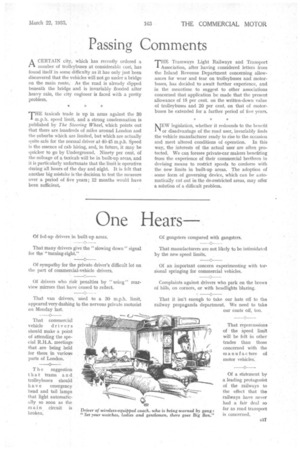Passing Comments
Page 31

If you've noticed an error in this article please click here to report it so we can fix it.
ACERTAIN city, which has recently ordered a number of trolleybuses at considerable cost, has found itself in some difficulty as it has only just been discovered that the vehicles will not go under a bridge on the main route. As the road is already dipped beneath the bridge and is invariably flooded after heavy rain, the city engineer is faced with a pretty problem.
THE taxicab trade is up in arms against the 30 m.p.h. speed limit, and a strong condemnation is published by The Steering Wheel, which points out that there are hundreds of miles around London and the suburbs which are limited, but which are actually quite safe for the normal driver at 40-45 m.p.h. Speed is the essence of cab hiring, and, in future, it may be quicker to go by Underground. Ninety per cent, of the mileage of a taxicab will be in built-up areas, and it is particularly unfortunate that the limit is operative during all hours of the day and night It is felt that another big mistake is the decision to test the measure over a period of five years ; 12 months would have been sufficient. THE Tramways Light Railways and Transport Association, after having considered letters from the Inland Revenue Department concerning allowances for wear and tear on trolleybuses and motorbuses, has decided to await further experience, and in the meantime to suggest to other associations concerned that application be made that the present allowance of 15 per cent, on the written-down value of trolleybuses and 20 per cent, on that of motorbuses be extended for a further period of five years.
NEW legislation, whether it redounds to the benefit or disadvantage of the road user, invariably finds the vehicle manufacturer ready to rise to the occasion and meet altered conditions of operation. In this way, the interests of the actual user are often protected. We can foresee private-car makers benefiting from the experience of their commercial brethren in devising means to restrict speeds to conform with the new limits in built-up areas. The adoption of some form of governing device, which can be automatically cut out in the de-restricted areas, may offer a solution of a difficult problem.




























































































